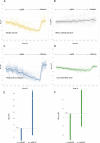Carotid artery velocity time integral and corrected flow time measured by a wearable Doppler ultrasound detect stroke volume rise from simulated hemorrhage to transfusion
- PMID: 35012624
- PMCID: PMC8750810
- DOI: 10.1186/s13104-021-05896-y
Carotid artery velocity time integral and corrected flow time measured by a wearable Doppler ultrasound detect stroke volume rise from simulated hemorrhage to transfusion
Abstract
Objective: Doppler ultrasonography of the common carotid artery is used to infer stroke volume change and a wearable Doppler ultrasound has been designed to improve this workflow. Previously, in a human model of hemorrhage and resuscitation comprising approximately 50,000 cardiac cycles, we found a strong, linear correlation between changing stroke volume, and measures from the carotid Doppler signal, however, optimal Doppler thresholds for detecting a 10% stroke volume change were not reported. In this Research Note, we present these thresholds, their sensitivities, specificities and areas under their receiver operator curves (AUROC).
Results: Augmentation of carotid artery maximum velocity time integral and corrected flowtime by 18% and 4%, respectively, accurately captured 10% stroke volume rise. The sensitivity and specificity for these thresholds were identical at 89% and 100%. These data are similar to previous investigations in healthy volunteers monitored by the wearable ultrasound.
Keywords: Carotid Doppler; Corrected flow time; Stroke volume; Velocity time integral.
© 2021. The Author(s).
Conflict of interest statement
JESK, ME, ZY, AME, JKE are employees of Flosonics Medical, a start-up building the wearable ultrasound, IB reports consulting fees for GE Healthcare, DCM, CHK and BDJ report no conflicts.
Figures



